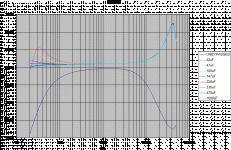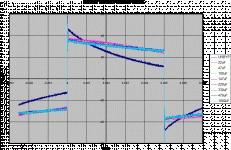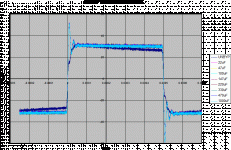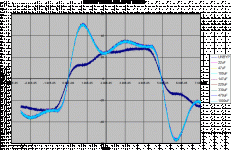Here are some results obtained with an ECC99 driving a Hashimoto A105 IT. The ECC 99 (rp is nominally 2.3K) was biased at 180Vp, -6.3Vg, Ip ~12.3mA, Rk = 511 ohms. As you can see, the HF peaking is determined by the rp of the tube. You can tweak the low end by judicious selection of the bypass cap value. If there is sufficient interest, I'll continue to post results. I'm staying with this family of tubes. Up next is the 12BH7A (rp ~5.3K and has the same pinout), then 5687 (rp ~3K at the bias I will use). I'll probably go back to the 46 at maybe 45 at some point (biased at 15mA). Enjoy.
Attachments
I am very intrested. I am running 12BH7A/ IT O'Netics level II into 6v6 SE UL using Hashimoto H-20-7U in fixed battery bias on the outputs. I am soon to run the Hashimoto IT against the O'Netics. How does the 12BH7A sound as driver in your amp..? In mine it came as a blessing using the 12BH7A, it has beat all tried as driver in in my IT coupled 2 stage. I didn't think this would happen & did not expect much, since I was using 26/27/6sn7/e80CC, etc,,as drivers. Also impressive are the Hashimoto OT's. I have nothing but good to say & no measurements to show for it though. What are your outputs & is this a 2 stage amp..?
I'm very, very interested too. Can you look at the response below 20Hz? I expect you'll see massive amounts of subsonic peaking until you have cathode bypass caps on the order of 470uF or so.
You might want to try fixed bias as well as cathode bias - this should eliminate the subsonic peaking.
Higher rp tubes will tame the ultrasonic peaking (ringing) and also reduce overshoot on the leading/trailing edges of the square wave response, the question of course is what effect that has on LF extension. (Reduces overall circuit q)
Square wave response particularly at 10kHz is not that impressive. I know there is not enough bandwidth to get a good square wave at these frequencies but the overshoot is quite significant.
Wondering whether a resistive load on the secondary side might tame some of this.
I was going to use IT coupling in my next amplifier, these pix are causing me to reconsider.
You might want to try fixed bias as well as cathode bias - this should eliminate the subsonic peaking.
Higher rp tubes will tame the ultrasonic peaking (ringing) and also reduce overshoot on the leading/trailing edges of the square wave response, the question of course is what effect that has on LF extension. (Reduces overall circuit q)
Square wave response particularly at 10kHz is not that impressive. I know there is not enough bandwidth to get a good square wave at these frequencies but the overshoot is quite significant.
Wondering whether a resistive load on the secondary side might tame some of this.
I was going to use IT coupling in my next amplifier, these pix are causing me to reconsider.
Hi JB,
Very interested to hear about your future findings on this thread. As you are running the A-105 with no load (scope input is minimal) I would expect some odd output... Perhaps try a 40K load resistor and see what difference this makes.
Hashimoto do recommend a 6AH4 as a possible driver. Not sure a 45 would be a good match as it typically runs best around 35ma which is far beyond the A-105 rating of 15ma.
What output voltage are you looking to get from the driver circuitry??
Regards, KM
Very interested to hear about your future findings on this thread. As you are running the A-105 with no load (scope input is minimal) I would expect some odd output... Perhaps try a 40K load resistor and see what difference this makes.
Hashimoto do recommend a 6AH4 as a possible driver. Not sure a 45 would be a good match as it typically runs best around 35ma which is far beyond the A-105 rating of 15ma.
What output voltage are you looking to get from the driver circuitry??
Regards, KM
JandG said:I How does the 12BH7A sound as driver in your amp..? What are your outputs & is this a 2 stage amp..?
I've just got the IT in a test fixture at the moment looking at various driver candidates. I'm aiming for a 2 stage 300B amp with Hashimoto ITs and OPTs. I can get away with a medium mu tube as I have a buffer amp with about 6 dB of gain between the CD player and the amp. If the 46 looks best, I'll go 3 stage with a 56 as the input tube.
kevinkr said:I'm very, very interested too. Can you look at the response below 20Hz? You might want to try fixed bias as well as cathode bias - this should eliminate the subsonic peaking.
Square wave response particularly at 10kHz is not that impressive. I know there is not enough bandwidth to get a good square wave at these frequencies but the overshoot is quite significant.
Wondering whether a resistive load on the secondary side might tame some of this.
I'll look below 20 Hz with some of the upcoming candidates. I think the 10 KHz square wave looks bad because the over/undershoot is an artifact of the 5-6 dB peaking at 40Khz with this rp. I'm wondering whether this would even be audible with most CD players as a source.
Fixed bias is an idea... I'll see what I can rig up. If I set up some sort of battery bias, is it better on the grid or in the cathode? I'd lean towards alkalines on the grid...
kmaier said:Hi JB,
What output voltage are you looking to get from the driver circuitry?? Regards, KM
I'm looking to swing about 45Vrms, a 300B at about -60Vg. The ECC99 does it easily as does the 46 (200Vp, -30Vg @ 15 mA).
Other tubes in the queue include 6S4A, 6C45Pi, 8532(6J4) marginal headroom though, and maybe some pentode configurations that I saw in Terman's "Radio Engineering". If anyone has any other suggestions, let me know. Ideal would be a gain of 25-30 and an rp around 3.5-4K...
I would go with alkalines on the grid, (conventional grid bias) while I have experimented with battery bias in the cathode circuit I have not always been impressed with the result. Sanyo NiCad seem to sound better than any brand of NiMH I have tried (Just a few) but sounded better still with a large electrolytic across them.. Do not use an alkaline as the cathode location results in a charging current during operation that can result in a really big mess - basically the alkaline cells will burst and spew electrolyte everywhere. (OR Worse  )
)
 )
)- Status
- This old topic is closed. If you want to reopen this topic, contact a moderator using the "Report Post" button.
- Home
- Amplifiers
- Tubes / Valves
- Hashimoto A105 - some results (ECC99)



